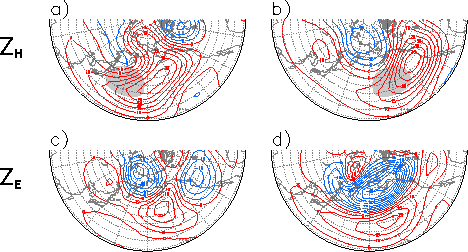2.3 Understanding the impact of extratropical SST variations
Despite many studies, the precise role of extratropical SST variations in the dynamics of atmospheric low-frequency variability remains unclear. Many atmospheric GCM experiments have been performed with prescribed extratropical SST anomalies to determine the atmospheric response to them. The results have been variable and confusing, not only because the response is weak and difficult to establish in short integrations, but also because it is sensitive to the precise location of the prescribed SST anomaly in relation to the atmospheric jet streams and their associated storm tracks. The largest extratropical SST anomalies tend to occur near the jets, and may be thought of as having a direct effect on the mean flow, and on the storm tracks through the change in the mean flow. The altered storm tracks can, however, feed back on the mean flow. This indirect effect can be very important, but is difficult for GCMs to represent accurately.
We have investigated these issues in a series of long NCEP AGCM runs with prescribed extratropical SST forcing. In a previously published study, an idealized warm SST anomaly was imposed near the Kuroshio region of the northwest Pacific. The atmospheric response to this was radically different in perpetual January and perpetual February integrations of the GCM: a baroclinic response in January and a nearly equivalent-barotropic ridge response in February. To understand this, we used a linear model to investigate the response to the SST anomaly as the sum of the direct heating-induced component and the indirect eddy-driven component associated with the altered storm tracks. (A novel feature of this calculation was that the altered storm-track forcing specified in the linear model was specifically that induced by the heating altered mean flow, diagnosed using Whitaker and Sardeshmukh's storm-track model). This diagnosis confirmed the dominance of the eddy-driven component, forced mainly by the altered eddy-momentum fluxes, in determining the barotropic ridge response. Without the eddy forcing, the response to a shallow heat source associated with the warm SST anomaly was always baroclinic, with a trough near the surface and a ridge aloft and downstream. This explains the baroclinic response to extratropical SST anomalies obtained in many low-resolution GCMs, in which the simulated storm tracks and eddy momentum-fluxes are generally too weak: in such GCMs the SST-induced alterations of the storm track are also too weak. An equivalent-barotropic ridge response develops only if the storm track is altered sufficiently strongly that strong anomalous eddy-forcing is generated at the correct locations to reinforce the heating-induced upper-level ridge and offset the lower-level trough. In this way, the atmospheric response becomes sensitive to the characteristics of the storm track and the position of the SST anomaly relative to the storm track.
As an example, Fig. 2.11 shows the linear model results for idealized shallow heat sources associated with warm extratropical SST anomalies imposed on the observed winter-mean basic state. With an elliptic source specified over the western Pacific (left panels), the heating-induced upper-level ridge (upper panel) is reinforced by the eddy-driven equivalent-barotropic ridge (lower panel) over the Pacific, similar to the GCM's February response. No such reinforcement by the transients occurs for a similar source specified over the eastern Pacific (right panels).
